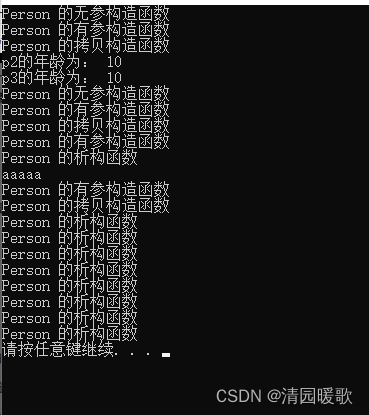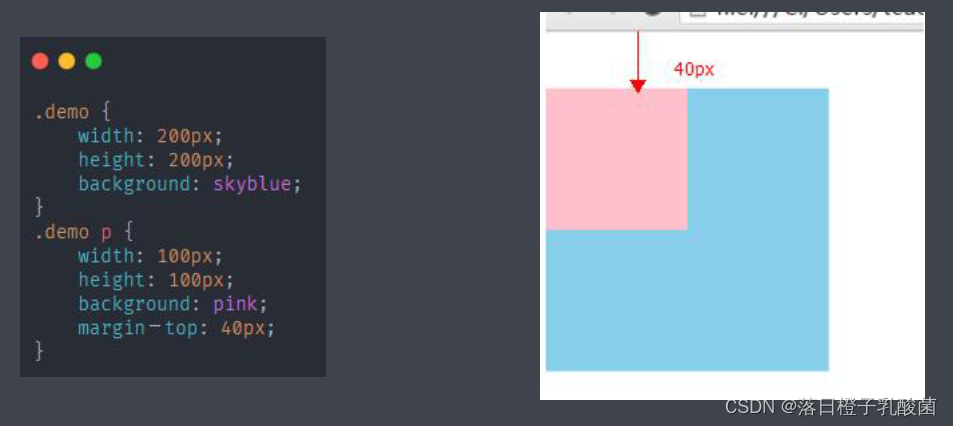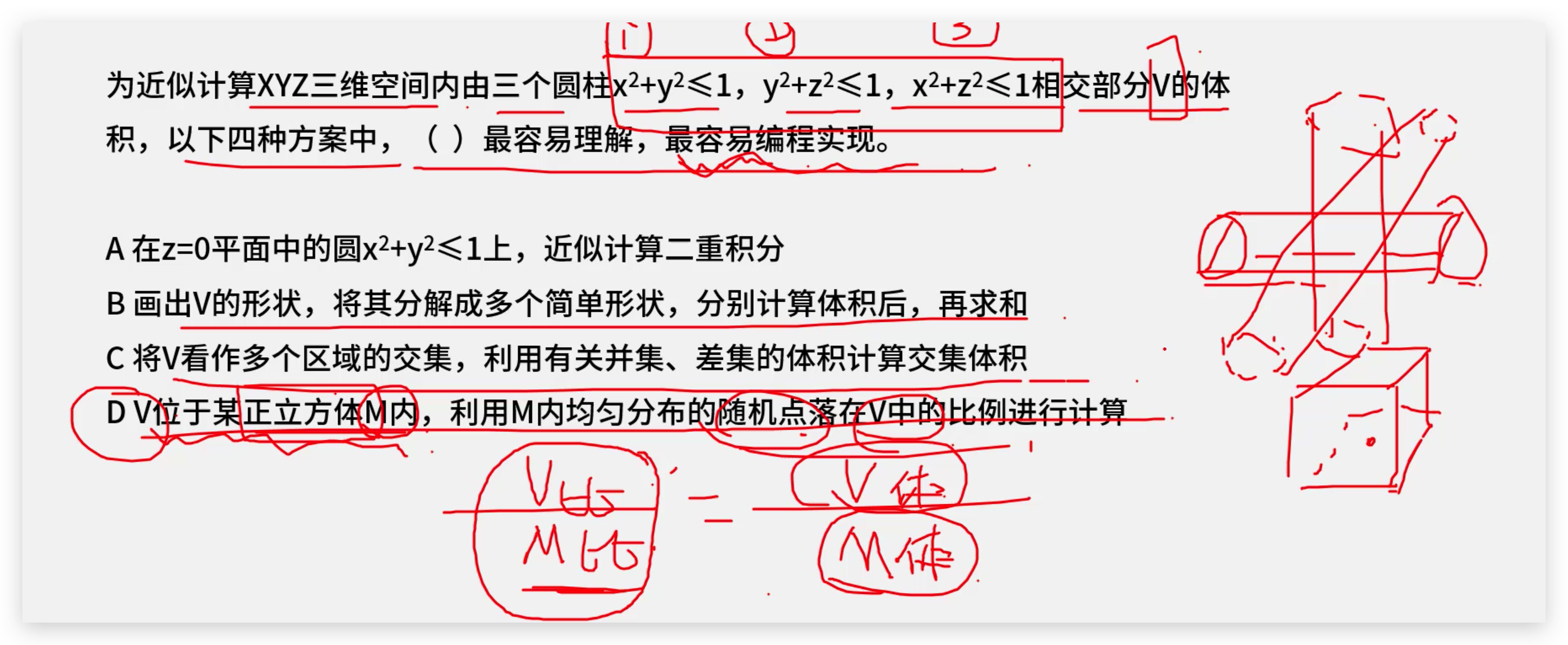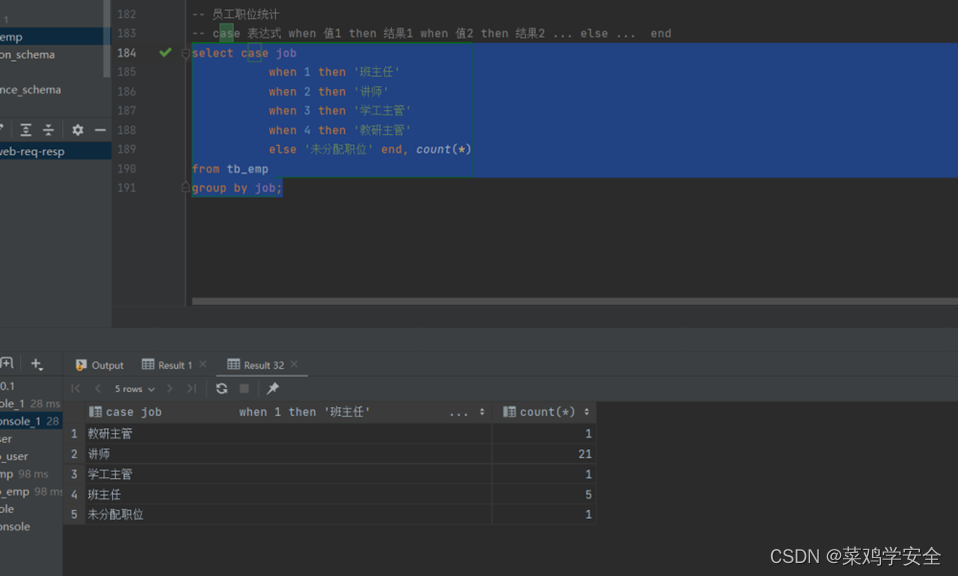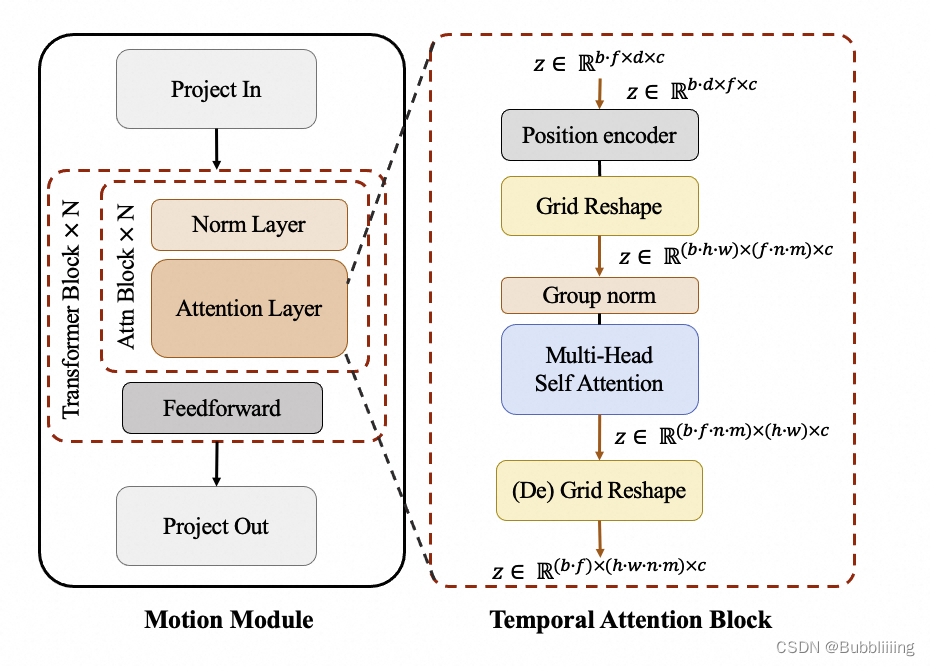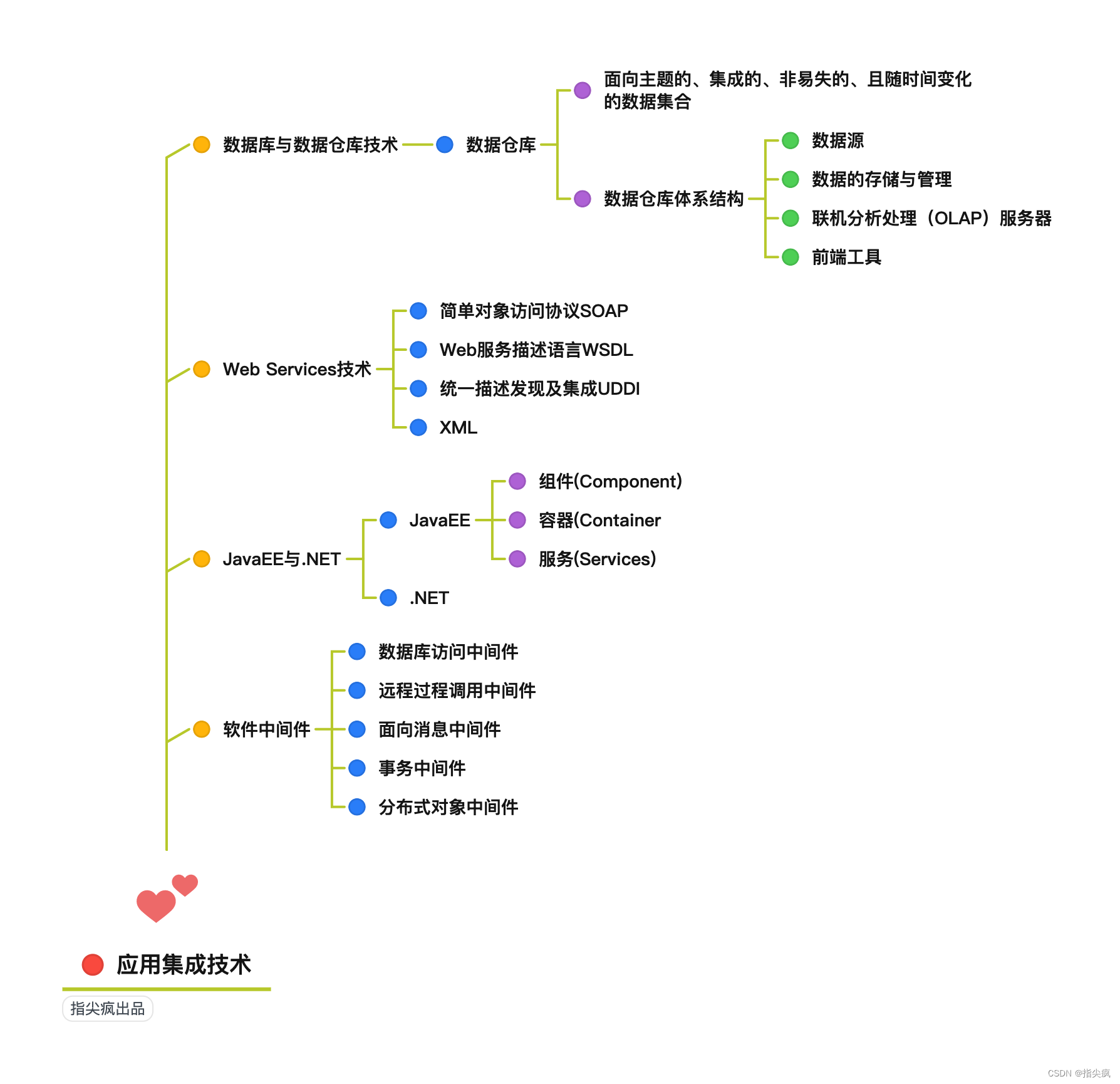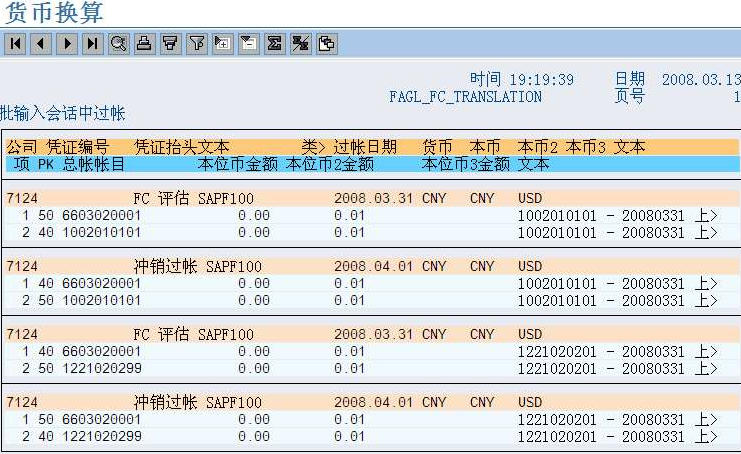一、内存区分模型

1.1 程序运行前

#include<iostream>
using namespace std;// 全局变量
int g_a = 10;
int g_b = 20;// const修饰的全局变量,全局常量
const int c_g_a = 10;
const int c_g_b = 20;int main()
{// 全局区// 全局变量、静态变量、常量// 创建普通局部变量int a = 10;int b = 10;cout << "局部变量a的地址为:" << (int)&a << endl;cout << "局部变量b的地址为:" << (int)&b << endl;cout << "局部变量g_a的地址为:" << (int)&g_a << endl;cout << "局部变量g_b的地址为:" << (int)&g_b << endl;// 静态变量,普通变量前面加staticstatic int s_a = 10;static int s_b = 20;cout << "局部变量s_a的地址为:" << (int)&s_a << endl;cout << "局部变量s_b的地址为:" << (int)&s_b << endl;// 常量// 字符串常量cout << "字符串常量的地址为:" << (int)&"hello world" << endl;// const修饰的变量// const修饰的全局变量, const修饰的局部变量cout << "全局常量 c_g_a 的地址为: " << (int)&c_g_a << endl;cout << "全局常量 c_g_b 的地址为: " << (int)&c_g_b << endl;const int c_l_a = 10; // c - const g - global l - localconst int c_l_b = 20;cout << "局部常量 c_l_a 的地址为: " << (int)&c_l_a << endl;cout << "局部常量 c_l_b 的地址为: " << (int)&c_l_b << endl;system("pause");return 0;
}


1.2 程序运行后
1.2.1 栈区
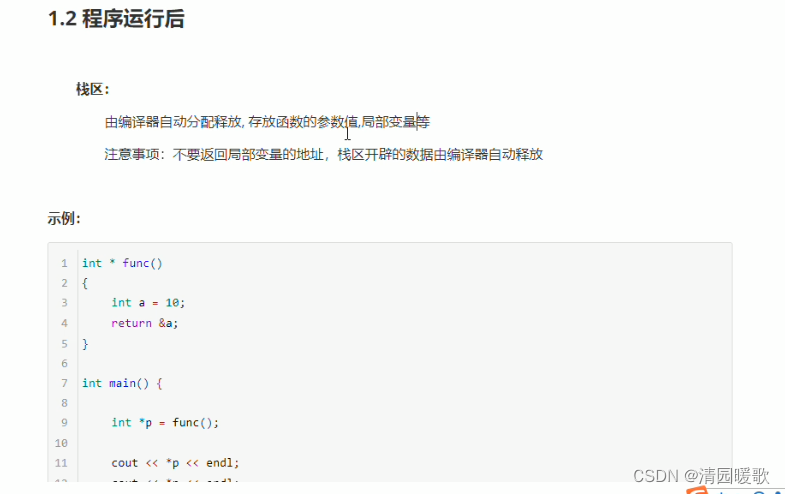
#include<iostream>
using namespace std;// 栈区数据的注意事项 --- 不要返回局部变量的地址
// 栈区的数据由编译器管理开辟和释放int* func()
{int a = 10; // 局部变量 存放在栈区,栈区的数据在函数执行完后自动释放return &a; // 返回局部变量地址
}//int* func2(int b ) // 形参数据也会放在栈区
//{
// b = 100;
// int a = 10; // 局部变量 存放在栈区,栈区的数据在函数执行完后自动释放
// return &a; // 返回局部变量地址
//}int main()
{// 接受func函数的返回值int* p = func();// int* p2 = func2(1);cout << *p << endl; // 10,第一次可以打印正确的数字,是因为编译器做了保留cout << *p << endl; // 1649252744,第二次这个数据就不再保留了system("pause");return 0;
}
1.2.2 堆区

#include<iostream>
using namespace std;// int * func()
{// 利用new关键字 可以将数据开辟到堆区// 指针 本质也是局部变量,放在栈上,指针保存的数据是放在栈区int *p = new int(10);return p;
}int main()
{// 在堆区开辟数据int* p = func();cout << *p << endl; // 10cout << *p << endl; cout << *p << endl;cout << *p << endl;system("pause");return 0;
}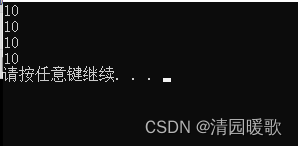

1.3 new操作符

#include<iostream>
using namespace std;// 1、new的基本语法
int* func()
{// 在堆区创建一个整型的数据// new返回的是该数据类型的指针int *p = new int(10); //return p;
}void test01()
{int* p = func();cout << *p << endl;cout << *p << endl;cout << *p << endl;// 堆区的数据 由程序员管理开辟,程序员管理释放// 如果想释放堆区的数据, 利用关键字deletedelete p;cout << *p << endl; // 会报错,因为已经释放了,无法访问,但是前三次正常输出// 内存已经被释放,再次访问j就是非法操作,会报错
}// 2、在堆区利用new开辟数组
void test02()
{// 创建10整型数据的数组,在堆区int * arr = new int[10]; // 10代表数组有10个元素for(int i = 0; i < 10; i++){arr[i] = i + 100; // 给10个元素赋值 100 ~ 109cout << arr[i] << endl;}// 释放堆区数组// 释放数组的时候 要加[]才可以delete[] arr;
}int main()
{// test01();test02();system("pause");return 0;
}
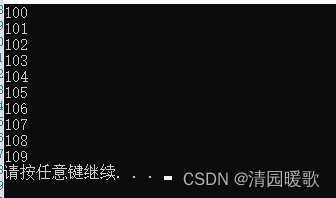
二、引用
2.1 引用的基本使用


#include <iostream>
using namespace std;int main()
{// 引用基本语法// 数据类型 &别名 = 原名int a = 10;// 创建引用int& b = a;cout << "a = " << a << endl;cout << "b = " << b << endl;b = 100;cout << "a = " << a << endl;cout << "b = " << b << endl;system("pause");return 0;
}
2.2 引用注意事项
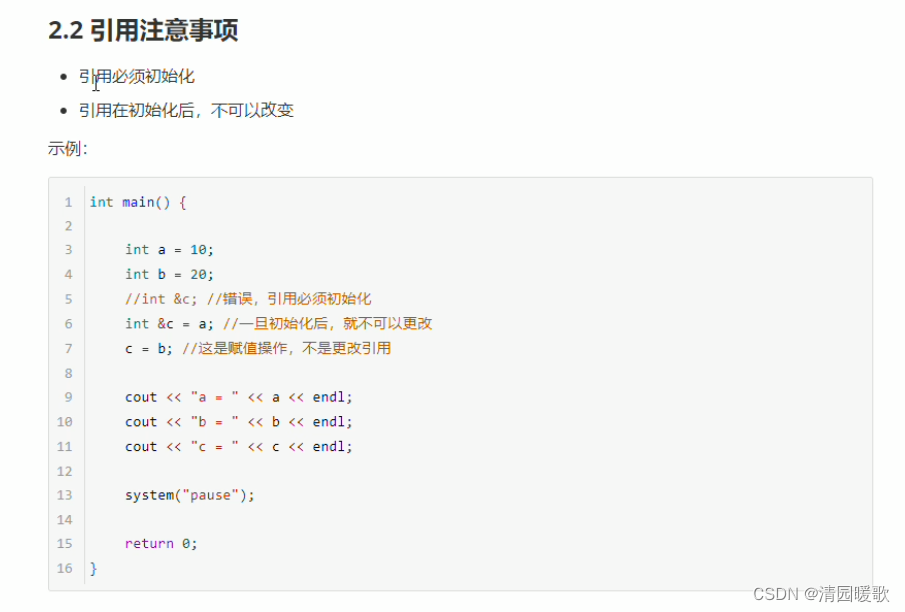
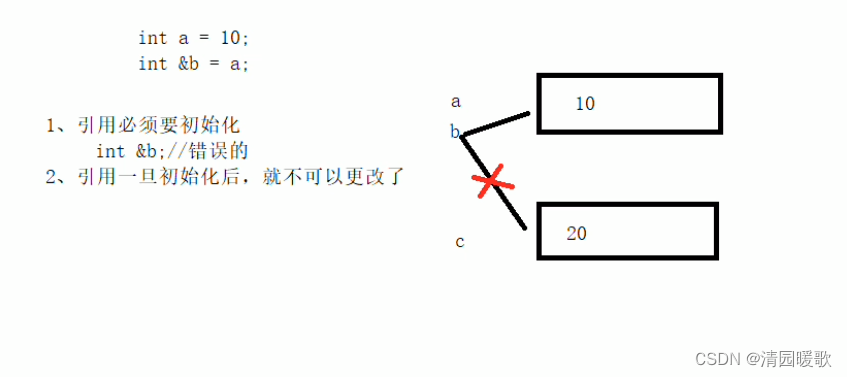
#include <iostream>
using namespace std;int main()
{int a = 10;// 1、引用必须初始化// int &b; // 错误,必须要初始化int& b = a;// 2、引用在初始化后,不可以改变int c = 20;b = c; // 赋值操作,而不是更改引用cout << "a = " << a << endl;cout << "b = " << b << endl;cout << "c = " << c << endl;system("pause");return 0;
}
2.3 引用做函数参数

#include <iostream>
using namespace std;// 交换函数// 1、值传递
void mySwap01(int a, int b)
{int temp = a;a = b;b = temp;cout << "swap01 a = " << a << endl;cout << "swap01 b = " << b << endl;
}// 2、地址传递
void mySwap02(int *a, int *b)
{int temp = *a;*a = *b;*b = temp;cout << "swap02 a = " << *a << endl;cout << "swap02 b = " << *b << endl;
}// 3、引用传递
void mySwap03(int &a, int &b)
{int temp = a;a = b;b = temp;cout << "swap03 a = " << a << endl;cout << "swap03 b = " << b << endl;
}int main()
{int a = 10;int b = 20;mySwap01(a, b); // 值传递,形参不会修饰实参cout << "a = " << a << endl;cout << "b = " << b << endl;mySwap02(&a, &b); // 地址传递,形参会修饰实参cout << "a = " << a << endl;cout << "b = " << b << endl;mySwap03(a, b); // 引用传递,形参会修饰实参cout << "a = " << a << endl;cout << "b = " << b << endl;system("pause");return 0;
}

2.4 引用做函数返回值

#include <iostream>
using namespace std;// 引用做函数的返回值
// 1、不要返回局部变量的引用
int& test01()
{int a = 10; // 局部变量存放在四区中的 栈区return a;
}// 2、函数的调用可以作为左值
int& test02()
{static int a = 10; // 静态变量,存放在全局区,全局上的数据在程序结束后系统释放return a;
}int main()
{int &ref = test01();cout << "ref = " << ref << endl; // 第一次结果正确,编译器做了保留cout << "ref = " << ref << endl; // 第二次结果错误,因为a的内存已经释放int& ref2 = test02();cout << "ref2 = " << ref2 << endl;cout << "ref2 = " << ref2 << endl;test02() = 1000; // 左值就是等式左边的值// 如果函数的返回值是引用,这个函数调用可以作为左值cout << "ref2 = " << ref2 << endl;cout << "ref2 = " << ref2 << endl;system("pause");return 0;
}
2.5 引用的本质


#include <iostream>
using namespace std;// 发现是引用,转换为 int* const ref = &a;
void func(int& ref) {ref = 100; // ref是引用,转换为*ref = 100
}int main()
{int a = 10;// 自动转换为 int* const ref = &a; 指针常量是指针指向不可改,也说明为什么引用步可更改int& ref = a;ref = 20; // 内部发现ref是引用,自动帮我们转换为: *ref = 20;cout << "a = " << a << endl;cout << "ref = " << ref << endl;system("pause");return 0;
}
2.6 常量引用


#include <iostream>
using namespace std;// 打印数据函数
void showValue(int &val)
{val = 1000;cout << "val = " << val << endl;
}void showValue2(const int& val)
{// val = 1000; // 错误cout << "val = " << val << endl;
}int main()
{// 常量引用// 使用场景:用来修饰形参,防止误操作/*int a = 10;int& ref = a;*/// 不允许 int& ref = 10; // 引用必须引一块合法的内存空间// 加上const之后 编译器将代码修改 int temp = 10; const int & ref = temp;// const int& ref = 10; // 引用必须引一块合法的内存空间// ref = 20; // 加入const之后变为只读,不可以修改int a = 100;showValue(a);cout << "a = " << a << endl;system("pause");return 0;
}
三、函数提高
3.1 函数默认参数

#include<iostream>
using namespace std;// 函数默认参数// 如果我们自己传入数据,就用自己的数据,如果没有,那么用默认值
// 语法:返回值类型 函数名(形参 = 默认值)
int func(int a, int b = 20, int c = 30)
{return a + b + c;
}// 注意事项
// 1、如果某个位置已经有了默认参数,那么从这个位置往后,从左到右都必须有默认值
//int func2(int a, int b = 10, int c) // 会报错
//{
// return a + b + c;
//}// 2、如果函数声明有默认参数,函数实现就不能有默认参数
// 声明和实现只能有一个有默认参数
int func2(int a = 10, int b = 10);int func2(int a = 10, int b = 10)
{return a + b;}// 这样写可以
//int func2(int a, int b)
//{
// return a + b;
//
//}int main()
{cout << func(10, 20, 30) << endl;cout << func(10) << endl;cout << func(10, 30) << endl;// cout << fun2(10, 10) << endl; // 运行会报错system("pause");return 0;
}
3.2 函数占位参数

#include<iostream>
using namespace std;// 占位参数
// 返回值类型 函数名(数据类型){}// 目前阶段的占位参数 还用不到,后面会用到
// 占位参数 还可以有默认参数
// void func(int a, int )
// {}
// func(10);
void func(int a, int = 10)
{cout << "this is func" << endl;
}int main()
{func(10, 10);system("pause");return 0;
}3.3 函数重载
3.3.1 函数重载概述

#include<iostream>
using namespace std;// 函数重载
// 可以让函数名相同,提高复用性// 函数重载的满足条件
// 1、同一个作用域下
// 2、函数名称相同
// 3、函数参数类型不同,或者个数不同,或者顺序不同
void func()
{cout << "func 的调用" << endl;
}// 个数不同
void func(int a)
{cout << "func(int a) 的调用!" << endl;
}// 类型不同
void func(double a)
{cout << "func(double a) 的调用!" << endl;
}// 顺序不同
void func(int a, double b)
{cout << "func(int a, double b) 的调用!" << endl;
}
void func(double a, int b)
{cout << "func(double a, int b) 的调用!" << endl;
}// 注意事项
// 函数的返回值不可以作为函数重载的条件
// 如下,会报错
//int func(double a, int b)
//{
// cout << "func(double a, int b) 的调用!" << endl;
//}int main()
{func();func(10);func(3.14);func(10, 3.14);func(3.14, 10);system("pause");return 0;
}
3.3.2 函数重载注意事项

#include<iostream>
using namespace std;// 函数重载的注意事项
// 1、引用作为重载的条件
void func(int &a) // int &a = 10; 不合法的
{cout << "func(int &a)调用" << endl;
}void func(const int& a) // const int &a = 10; 合法
{cout << "func(const int &a)调用" << endl;
}// 2、函数重载碰到默认参数
void func2(int a, int b = 10)
{cout << "func2(int a, int b) 的调用" << endl;
}void func2(int a)
{cout << "func2(int a) 的调用" << endl;
}int main()
{int a = 10;func(a); // 调用的是 int &a,a是变量,加了const是只读状态就不能写,将变量传入就是可读可写的func(10);// func2(10); // 当函数重载碰到默认参数,出现二义性,此时报错,尽量避免func2(10, 20); // 没问题system("pause");return 0;
}
四、类和对象
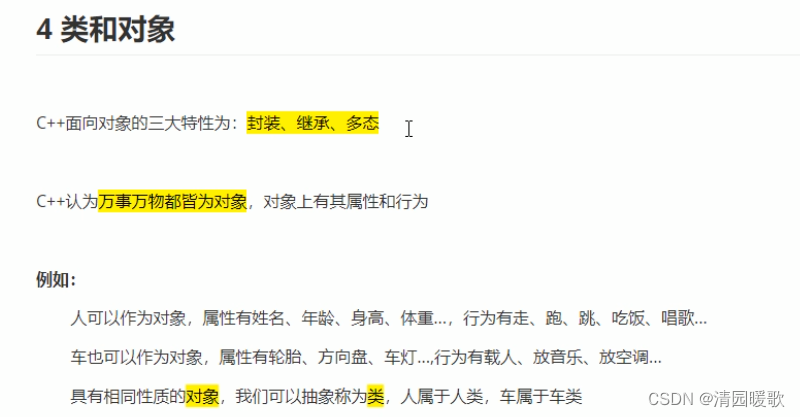
4.1 封装
4.1.1 封装的意义(类)

#include<iostream>
using namespace std;// 圆周率
const double PI = 3.14;// 设计一个圆类,求圆的周长
// 圆求周长的公式: 2 * pi * r(半径)// class 代表设计一个类,类后面紧跟着的就是类名称
class Circle
{// 访问权限// 公共权限
public:// 属性// 半径int m_r;// 行为// 获取圆的周长double calculateZC(){return 2 * PI * m_r;}
};int main()
{// 通过圆类 创建具体的圆(对象)// 实例化 (通过一个类 创建一个对象的过程)Circle c1;// 给圆对象 的属性进行赋值c1.m_r = 10;// 2 * PI * 10 = 62.8cout << "圆的周长为: " << c1.calculateZC() << endl;system("pause");return 0;
}
4.1.2 示例:学生类

#include<iostream>
using namespace std;
#include<string>// 设计一个学生类,属性有姓名和学号,I
// 可以给姓名和学号赋值,可以显示学生的姓名和学号// 设计学生类
class Student
{// 访问权限// 公共权限
public:// 类中的属性和行为 我们统一称为 成员// 属性 成员属性 成员变量// 行为 成员函数 成员方法// 属性string m_name; // 姓名int m_id; // 学号// 行为// 显示姓名和学号void showStudent(){cout << "姓名: " << m_name << endl;;cout << "学号: " << m_id << endl;}// 给姓名赋值void setName(string name){m_name = name;}// 给学号赋值void setid(int id){m_id = id;}
};int main()
{// 创建一个具体学生// 实例化对象 (通过一个类 创建一个对象的过程)Student s1;// 给学生对象 的属性进行赋值// s1.m_name = "张三";s1.setName("李四");// s1.m_id = 1;s1.setid(2);// 显示学生信息s1.showStudent();// 除了直接赋值,还可以通过行为给属性赋值system("pause");return 0;
}
self:
#include<iostream>
using namespace std;
#include<string>// 设计一个学生类,属性有姓名和学号,I
// 可以给姓名和学号赋值,可以显示学生的姓名和学号class Student
{// 访问权限// 公共权限
public:// 属性int xuehao;string name;void xianshi(){cout << "姓名为: " << name << endl;cout << "学号为: " << xuehao << endl;}
};int main()
{Student s1;s1.name = "张三";s1.xuehao = 20010123;s1.xianshi();system("pause");return 0;
}4.1.3 封装的意义(权限)

#include<iostream>
using namespace std;
#include<string>// 访问权限
// 三种
// 公共权限 public 成员 类内可以访问 类外可以访问
// 保护权限 protected 成员 类内可以访问 类外不可以访问 儿子可以访问父亲中的保护内容
// 私有权限 private 成员 类内可以访问 类外不可以访问 儿子不可以访问父亲的私有内容
// 继承的时候 保护 和 私有就有区别了class Person
{public:// 公共权限string m_name; // 姓名protected:// 保护权限string m_car;private:// 私有权限int m_password;private: // 这也是类内void func(){m_name = "张三";m_car = "拖拉机";m_password = 123456;}};int main()
{// 实例化具体对象Person p1;p1.m_name = "李四";p1.m_car = "奔驰"; // 保护权限内容,在类外访问不到p1.m_password = 123; // 私有权限内容,类外访问不到p1.func(); // 此时访问不到了,只有public访问的到system("pause");return 0;
}4.1.4 struct 和 class 区别

#include<iostream>
using namespace std;
#include<string>class C1
{int m_a; // 默认权限 是 私有
};struct C2
{int m_a; // 默认权限 是 公共
};int main()
{// struct 和 class 区别// struct 默认权限是 公共 oublic// class 默认权限是 私有 privateC1 c1;// c1.m_a = 100; // 会报错,class默认权限是 私有,类外不可以访问C2 c2;c2.m_a = 100; // 在struct默认的权限是 共有。类外可以访问system("pause");return 0;
}4.1.5 成员属性设置为私有

#include<iostream>
using namespace std;
#include<string>// 成员属性设置为私有
// 1、可以自己控制读写权限
// 2、对于写可以检测数据的有效性// 设计人 类
class Person
{
public:// 写姓名(设置姓名)void setname(string name){m_name = name;}// 读姓名(获取姓名)string getname(){return m_name;}// 获取年龄 可读可写 如果想修改(年龄的范围必须是 0 ~ 150 之间)int getage(){// m_age = 0; // 初始化为0岁return m_age;}// 设置年龄void setage(int age){if (age < 0 || age > 150){cout << "你这个老妖精!" << endl;return;}m_age = age;}// 设置情人 只写void setlover(string lover){m_lover = lover;}private:// 姓名 可读可写string m_name;// 年龄 只读int m_age;// 情人 只写string m_lover;
};int main()
{Person p;p.setname("张三");cout << "姓名为: " << p.getname() << endl;// p.m_age = 19; // 错误,只读p.setage(18);cout << "年龄为: " << p.getage() << endl;// 设置情人为苍井女士p.setlover("苍井");// cout << "情人为: " << p.m_lover << endl; // 不能直接访问system("pause");return 0;
}
4.1.6 封装案例 - 立方体

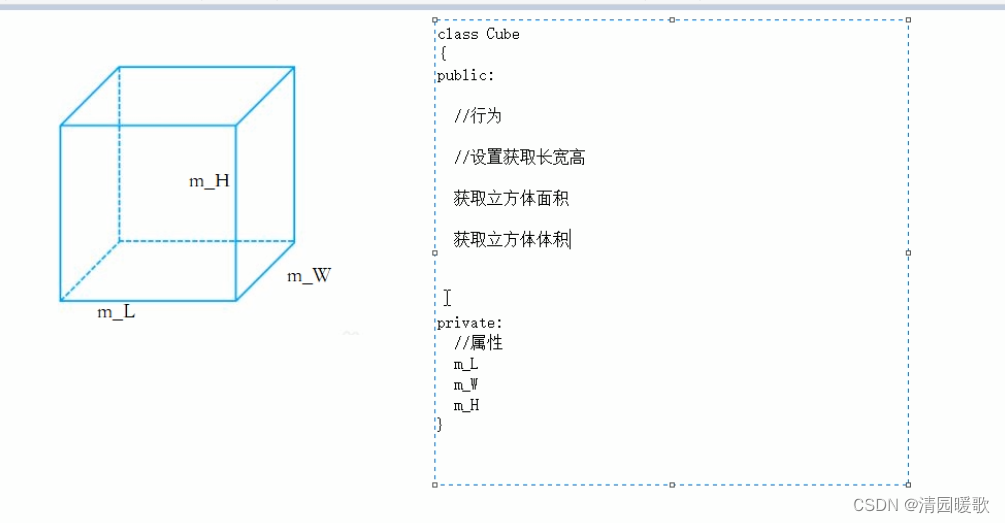
#include<iostream>
using namespace std;
#include<string>// 立方体类设计
// 1、创建立方体类
// 2、设计属性和行为
// 3、设计行为 获取立方体的面积和体积
// 4、分别利用全局函数和成员函数 判断两个立方体是否相等class Cube
{
public:// 设置长void setl(int l){m_l = l;}// 获取长int getl(){return m_l;}// 设置宽void setw(int w){m_w = w;}// 获取宽int getw(){return m_w;}// 设置高void seth(int h){m_h = h;}// 获取高int geth(){return m_h;}// 获取立方体面积int calculateS(){return 2 * m_l * m_w + 2 * m_l * m_h + 2 * m_w * m_h;}// 获取立方体体积int calculateV(){return m_l * m_h * m_w;}// 利用成员函数判断两个立方体是否相等bool isSameByClass(Cube &c){if (m_l == c.getl() && m_w == c.getw() && m_h == c.geth()){return true;}return false;}private:int m_l;int m_w;int m_h;};// 利用全局函数判断 两个立方体是否相等
bool isSame(Cube &c1, Cube &c2)
{if (c1.getl() == c2.getl() && c1.getw() == c2.getw() && c1.geth() == c2.geth()){return true;}return false;
}int main()
{// 创建一个立方体对象Cube c1;c1.setl(10);c1.setw(10);c1.seth(10);// 600cout << "立方体面积为: " << c1.calculateS() << endl;// 1000cout << "立方体体积为: " << c1.calculateV() << endl;// 创建第二个立方体Cube c2;c2.setl(10);c2.setw(10);c2.seth(10);// 利用全局函数判断bool ret = isSame(c1, c2);if (ret){cout << "c1和c2是相等的" << endl;}else{cout << "c1和c2是不相等的" << endl;}// 利用成员函数判断ret = c1.isSameByClass(c2);if (ret){cout << "成员函数判断: c1和c2是相等的" << endl;}else{cout << "成员函数判断: c1和c2是不相等的" << endl;}system("pause");return 0;
}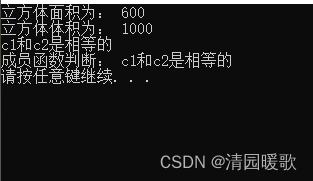
4.1.7 封装案例2 - 点和圆的关系

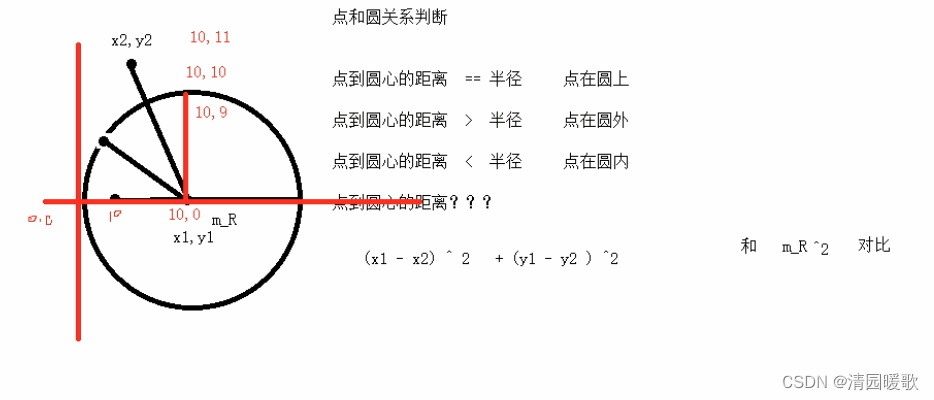
#include<iostream>
using namespace std;
#include<string>
#include "circle.h"
#include "point.h"// 点和圆的关系案例// 点类
class Point
{
public:// 设置xvoid setx(int x){m_x = x;}// 获取xint getx(){return m_x;}// 设置yvoid sety(int y){m_y = y;}// 获取yint gety(){return m_y;}private:int m_x;int m_y;
};// 圆类
class Circle
{
public:// 设置半径void setr(int r){m_r = r;}// 获取半径int getr(){return m_r;}// 设置圆心void setcenter(Point center){m_center = center;}// 获取圆心Point getcenter(){return m_center;}private:int m_r; // 半径// 在类中可以让另一个类 作为本类中的成员Point m_center; // 圆心};// 判断点和圆的关系
void isInCircle(Circle& c, Point& p)
{// 计算两点之间距离 平方int distance = (c.getcenter().getx() - p.getx())* (c.getcenter().getx() - p.getx()) +(c.getcenter().gety() - p.gety()) * (c.getcenter().gety() - p.gety());// 计算半径的平方int rdistance = c.getr() * c.getr();// 判断关系if (distance == rdistance){cout << "点在圆上" << endl;}else if (distance > rdistance){cout << "点在圆外" << endl;}else{cout << "点在圆内" << endl;}
}int main()
{// 创建圆Circle c;c.setr(10);Point center;center.setx(10);center.sety(0);c.setcenter(center);// 创建点Point p;p.setx(10);p.sety(9);// 判断关系isInCircle(c, p);system("pause");return 0;
}
可将类写到声明
point.h
#pragma once
#include<iostream>
using namespace std;// 点类
class Point
{
public:// 设置xvoid setx(int x);// 获取xint getx();// 设置yvoid sety(int y);// 获取yint gety();private:int m_x;int m_y;
};point.cpp
#include"point.h"// 设置x
void Point::setx(int x) // Point作用域下的成员函数
{m_x = x;
}// 获取x
int Point::getx()
{return m_x;
}// 设置y
void Point::sety(int y)
{m_y = y;
}// 获取y
int Point::gety()
{return m_y;
}
circle.h
#pragma once
#include<iostream>
using namespace std;
#include "point.h"// 圆类
class Circle
{
public:// 设置半径void setr(int r);// 获取半径int getr();// 设置圆心void setcenter(Point center);// 获取圆心Point getcenter();private:int m_r; // 半径// 在类中可以让另一个类 作为本类中的成员Point m_center; // 圆心};circle.cpp
#include "circle.h"// 设置半径
void Circle::setr(int r)
{m_r = r;
}
// 获取半径
int Circle::getr()
{return m_r;
}
// 设置圆心
void Circle::setcenter(Point center)
{m_center = center;
}
// 获取圆心
Point Circle::getcenter()
{return m_center;
}
4.2 对象的初始化和清理

4.2.1 构造函数和析构函数


#include<iostream>
using namespace std;// 对象的舒适化和清理
class Person
{
public:// 1、构造函数// 没有返回值 不用写void// 函数名 与类名相同// 构造函数可以有参数,可以发生重载// 创建对象的时候,构造函数会自动调用,而且只调用一次Person(){cout << "Person 构造函数的调用" << endl; // 编译器自动写的是空的}// 2、析构函数 进行清理的操作// 没有返回值 不写 void// 函数名和类名相同 在名称前加 ~// 析构函数不可以有参数的,不可以发生重载// 对象在销毁前 会自动调用析构函数,而且智慧调用一次~Person(){cout << "Person 的析构函数调用" << endl;}
};// 构造和析构都是必须有的实现,如果我们自己不提供,编译器会提供一个空实现的构造和析构
void test01()
{Person p; // 在栈上的数据,test01()执行完毕后,释放这个对象
}int main()
{test01(); // 这样直接会有析构// Person p; // 这样这个对象在执行完 return 0 之后才会析构system("pause");return 0;
}
4.2.2 构造函数的分类及调用

#include<iostream>
using namespace std;// 1、构造函数的分类及调用
// 分类
// 按照参数分类 无参构造(默认构造) 和 有参构造
// 按照类型分类 普通构造 拷贝构造
class Person
{
public:// 构造函数、普通构造Person(){cout << "Person 的无参构造函数" << endl;}Person(int a){age = a;cout << "Person 的有参构造函数" << endl;}// 拷贝构造函数Person( const Person &p ) // 把p的所有属性拷贝过来,但不能改,所以要const + 引用{// 将传入的人身上所有属性,拷贝到我身上cout << "Person 的拷贝构造函数" << endl;age = p.age;}~Person(){cout << "Person 的析构函数" << endl;}int age;
};// 调用
void test01()
{// 1、括号法Person p1; // 默认构造函数调用Person p2(10); // 有参构造函数Person p3(p2); // 拷贝构造函数// 注意事项// 调用默认构造函数时候,不要加()// 因为下面这行代码,编译器会认为是一个函数的声明,不会认为在创建对象// 如 void func(),因为在一个函数里可以写另一个函数的声明,所以不会报语法错误// Person p1(); // 这样调用不会创建对象,就没有构造和析构cout << "p2的年龄为: " << p2.age << endl;cout << "p3的年龄为: " << p3.age << endl;// 2、显示法Person p4;Person p5 = Person(100); // 有参构造Person p6 = Person(p5); // 拷贝构造Person(100); // 匿名对象 特点:当前行执行结束后,系统会立即回收掉匿名对象;构造和析构连一起cout << "aaaaa" << endl;// 注意事项2// 不要利用拷贝构造函数 初始化匿名对象,编译器会认为 Person(p6) == Person p3;对象声明// Person(p6); // 3、隐式转换法Person p7 = 10; // 相当于 写了 Person p7 = Person(10) 有参构造Person p8 = p7; // 拷贝构造
}int main()
{test01();// Person p; // 这样这个对象在执行完 return 0 之后才会析构system("pause");return 0;
}